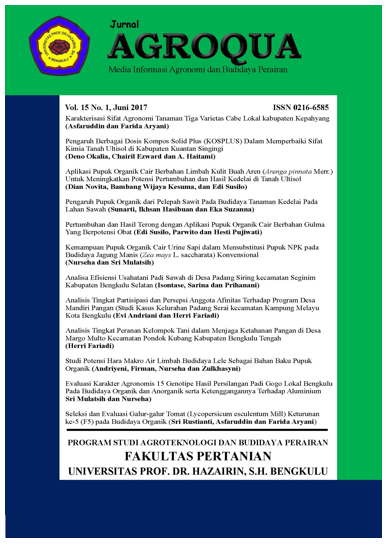PENGARUH PADAT TEBAR DAN SHELTER TERHADAP KELANGSUNGAN HIDUP DAN PERTUMBUHAN BENIH LOSBTER AIR TAWAR ( Cherax quadricarinatus )
DOI:
https://doi.org/10.32663/ja.v21i1.3608Keywords:
freshwater crayfish, stocking density, shelterAbstract
The problem that is often faced by crayfish cultivators at the moment is the low survival rate, especially when the seeds are also stocking density which is not known with certainty, especially during nursery activities and rearing of crayfish (Cherax quadricarinatus). This research was conducted for 60 days in Sukaraja District, Seluma Regency. This study aims to determine the effect of stocking density and shelter and interactions on the survival and growth of freshwater crayfish (Cherax quadricarinatus) fry. The study used a completely randomized factorial design with three replications. The first factor was stocking density consisting of A1 = 6 individuals (48/m²), A2 = 7 individuals (59/m²), and A3 = 8 individuals (68/m²). and the second factor is the shelter which consists of B1 = paralon pipe, B2 = roster stone and B3 = bamboo. If there is a significant effect, then the Duncant Multiple Range Test (DMRT) is carried out. The results showed that the stocking density treatment had a very significant effect on survival, molting percentage, absolute weight and absolute length but had no effect on feed conversion and feed efficiency, while the shelter treatment had no significant effect on all observed parameters. The interaction effect of stocking density and shelter treatment had a significant effect on absolute weight growth but had no effect on survival, moulting percentage, absolute length, feed conversion and feed efficiency. Stocking density of 6 individuals/48/m² container and paralon pipe shelters gave the best results for survival and growth of crayfish (Cherax quadricarinatus).
Downloads
Published
Issue
Section
License
Authors who publish with this journal agree to the following terms:
- Authors grant the journal right of first publication with the work simultaneously licensed under a Creative Commons Attribution 4.0 Internasional (CC BY 4.0) Licence that allows others to use and share the work with an acknowledgment of the work's authorship and initial publication in this journal.
- The author(s) still hold the copyright of his/her/their work and retain publishing rights without restrictions such as (but not limited to) patent right, lecture, book and reproduce the article for own purposes.
















